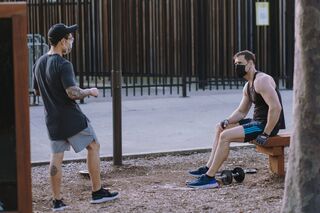Coronavirus Disease 2019
Under the Mask, Part 2
There are more layers to this issue than three pieces of cloth.
Posted May 17, 2020

My last post on masks proved divisive. I thought it might. This issue is too layered to capture in a thousand words. So here’s round two.
Some readers pointed out there are plenty of reasons why not everyone is wearing a mask —despite evidence that it's helping slow the spread of this coronavirus. They aren't about bravado or status-signaling. And they aren't cultural the way I framed them last time —collectivist countries falling in line with mask rules more than individualist ones.
Other forces are at work.
In the West, masks arouse suspicion. Negative connotations are still enshrined in law. The history of this runs deep. Part of it is outright racism. Recently, some folks have come forward in the U.S. press. They don’t particularly care to become even fatter targets of profiling and harassment the moment they put on a bandanna. “For me, the fear of being mistaken for an armed robber or assailant is greater than the fear of contracting COVID-19,” one black man told the Boston Globe.
In Canada, Quebec finds itself in a similarly uncomfortable spot. Muslim women in public-service jobs are forbidden to wear the traditional, face-covering hijab or naqab (under a law that says public servants can’t wear religious symbols). Yet Quebec’s premier just endorsed masks. “So,” asks the incisive journalist Elizabeth Renzetti, “is facial covering a transgression against our shared ideals or … is it not?”
And then there’s the practical issue of sustaining this practice. Wearing a mask all day is tougher than you might imagine.
“I’d encourage you to go spend a little time with the “front-liners” of grocery checkers, stockers, meat and produce handlers,” a California-based chef and sommelier gently chided me. “Go ask people who had never worn a mask for eight hours a day what they think of it.”
So I did. Most clerks at my local supermarket indeed said they were relieved when the province relaxed the rules and they could take a break from their mask. “There are people who still wear them for the full eight-hour shift, and hats off to them, I don’t know how they do it,” one checker told me. (Last time I was in the store I noticed a familiar employee, shuffled to line control, had swapped out her mask for a plastic face shield. “Hugely more comfortable,” she said.)
Recently, Avir Mitra, an exhausted frontline ER doctor in Manhattan, wondered how it was affecting his health to be double-bagging his face —a respirator with a medical mask over it. So he hooked up a couple of devices to measure gas exchange. The mask didn’t stop oxygen getting in, he discovered; so that was good. But it did stop carbon dioxide from getting out. Mitra’s CO2 levels climbed almost 50 percent in an hour.
That’s obviously not ideal in a frontline life-safer. But it’s equally obviously worth doing when the alternative is a high chance of catching COVID because you’re working with infected patients from dawn to dusk..
The California chef took strong issue with mandatory mask rules for backline workers — like commercial kitchen staff. "I would not ask anyone who has not been trained in the proper use, to wear one,” he said. “Every time a person adjusts their mask (or cloth face covering), they then contaminate everything they touch all day long. As it stands right now, I don't believe the general public has the proper guidance to wear masks responsibly."
(Here’s a primer on how to wear a mask correctly.)
In recent weeks, British Columbia has driven community transmission rates way down. Consequently, Team Mask has declined in number. In my local supermarket, maskless shoppers outnumber masked ones by, I’d say, four to one. (More women than men seem to be wearing them. Which is strange, since COVID-19 is hitting men harder.)
This signals, problematically, that masks are no longer needed. As fewer people wear masks, fewer people will wear masks. There’s a strong contagion effect with any behaviour in tight-knit communities—from deciding to go solar because your neighbour did to supporting each other’s opinions on Twitter.
But the very act of wearing a mask in public is likely to deepen your identity as a person to cares about others —never a bad thing, and sure to have positive cascade effects you’ll never live to see.
The mask issue isn’t going away. Science will be “playing whack-a-mole” with the virus, as science writer Ed Yong put it, until a vaccine is produced. In other words, as we get local transmission under control and relax travel constraints, new outbreaks will flare. “Flattening the curve” just means we take turns getting this thing.
But the people wearing masks in close quarters are the ones who may prevent a stranger from getting it at all.




